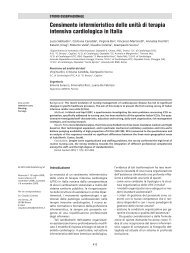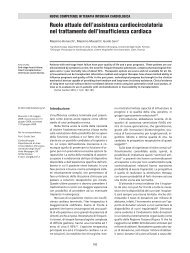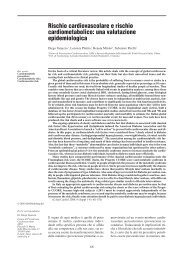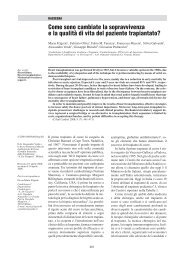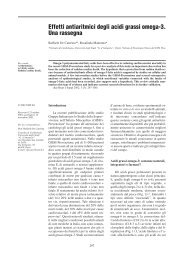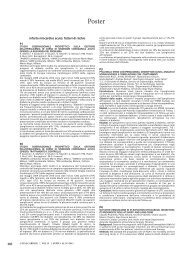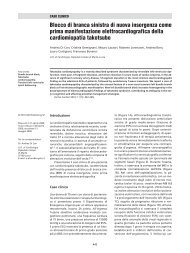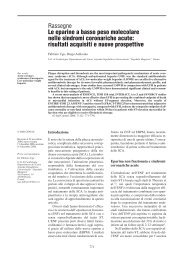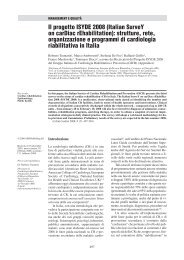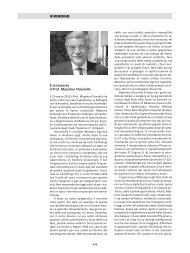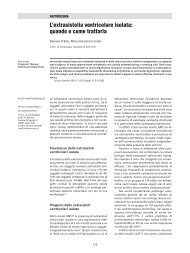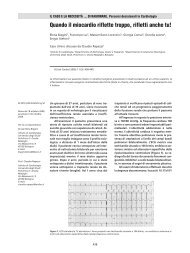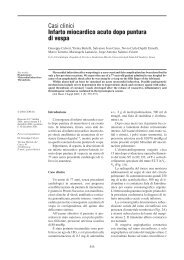COMUNICAZIONI - Giornale Italiano di Cardiologia
COMUNICAZIONI - Giornale Italiano di Cardiologia
COMUNICAZIONI - Giornale Italiano di Cardiologia
You also want an ePaper? Increase the reach of your titles
YUMPU automatically turns print PDFs into web optimized ePapers that Google loves.
Comunicazioni<br />
care unit/acute coronary admissions and for percutaneous coronary intervention<br />
(PCI) were used to record information. From October 2005, 16 (4 Male) consecutive<br />
patients (pts.) (mean age 50±11; range 30-68 years) were enrolled. Thirteen<br />
(81.2%) pts. had one or more risk factors for coronary artery <strong>di</strong>sease (CAD). In the<br />
female, no association with peripartum period was detect. The clinical presentation<br />
was typical chest pain in 13 (81.5%) patients; 1 (6,25%) had an aborted sudden<br />
car<strong>di</strong>ac death; the last two was asymptomatic. The SCAD <strong>di</strong>agnosis was made by<br />
an angiogram performed on the same day of hospital admission in all patients. Of<br />
the 4 men, 2 (50%) had SCAD of left anterior coronary artery (LAD); 2 had a<br />
<strong>di</strong>ssection of right coronary artery (RCA) and left circumflex artery (LCA),<br />
respectively. Of the 12 women, 7 (58,3%) showed SCDA of LAD; 4 (33%) had a<br />
<strong>di</strong>ssection of RCA and 1 of LCA. The classification for culprit SCAD types were: 7<br />
(48.8%) type B (parallel double lumen); 5 (31.2%) type D (spiral luminal filling<br />
defects); 3 (18.8%) type F (total occlusion); 1 (6.25%) type C (extraluminal cap). No<br />
correlation was detect between culprit artery and type of <strong>di</strong>ssection. Only 4 (25%)<br />
patients had a significant atherosclerotic stenosis of a vessel <strong>di</strong>fferent from culprit<br />
artery. Six (37.7%) patients were treated with PCI; 2 (12.5%) underwent CABG; 8<br />
(50%) received me<strong>di</strong>cal treatment. The final <strong>di</strong>agnoses were: 9 (56.2%) STEMI; 4<br />
(25%) NSTEMI; 2 (12.5%) Unstable Angina and 1 (6.25%) Stable CAD. The left<br />
ventricular ejection fraction during the hospital stay was normal in 11, slightly<br />
reduced in 4 and moderately reduced in 1 patient. An other interesting field of<br />
deepening will regard the accurate study of multi vessel <strong>di</strong>ssection (syncronous or<br />
less): 4 pts. (25%) in our first results. All patients were <strong>di</strong>scharged alive.<br />
Conclusions. Our series demonstrates the female prevalence among pts. with<br />
SCAD. Almost all patients were admitted with an acute coronary syndrome and<br />
completed a myocar<strong>di</strong>al infarction. Invasive treatment with PCI or CABG is not<br />
mandatory and the early outcome is favourable.<br />
C87<br />
STEM-AMI TRIAL: FATTIBILITÀ E DATI PRELIMINARI<br />
C. Malafronte*, G. Pompilio°, S. Maggiolini*, M. Pesce°, G. Mannino§, L. Piatti*,<br />
G. Tiberti*, F. Gentile§, A. DiLelio§, J. Baglivo*, C. Addamiano*, D. Skouse*,<br />
F. Achilli*<br />
*A.O. A. Manzoni, Lecco, °Centro Car<strong>di</strong>ologico Fondazione Monzino (CCFM)<br />
Milano, §A.O. San Gerardo, Monza<br />
Razionale. I Pazienti (Pz) con infarto miocar<strong>di</strong>co acuto (IMA) anteriore e<br />
sopraslivellamento del tratto ST (STEMI), presentano prognosi severa,anche<br />
quando sottoposti ai trattamenti raccomandati (PTCA primaria e terapia me<strong>di</strong>ca<br />
ottimizzata), con tempi <strong>di</strong> intervento ”ideali”. Lo sviluppo <strong>di</strong> <strong>di</strong>sfunzione e<br />
rimodellamento ventricolare, che rappresenta l’evento prognosticamente più<br />
rilevante in tale popolazione, ha prevalenza elevata soprattutto nei Pz con<br />
intervallo “symptom-balloon” >3 ore. Lo stu<strong>di</strong>o STEM-AMI (prospettico, fase II,<br />
randomizzato, “open-label”), prevede l’arruolamento <strong>di</strong> 50 Pz con STEMI<br />
anteriore, >3h, sottoposti a PTCA primaria efficace, con <strong>di</strong>sfunzione Vsx residua<br />
(FE ≤40%). I Pz sono randomizzati a terapia con G-CSF (5 mcg/kg/bid s.c.) per<br />
5 giorni (gg) consecutivi dopo la procedura, oppure a terapia convenzionale (Anti<br />
IIb/IIIa, ACEI, betabloccante, ASA).<br />
Scopo. Valutare l’efficacia clinica della mobilizzazione <strong>di</strong> cellule staminali da<br />
midollo osseo nel sangue periferico, in termini <strong>di</strong> incremento <strong>di</strong> FE del Vsx <strong>di</strong><br />
almeno il 5%, nei trattati vs controlli, misurata alla RMN a 6 mesi <strong>di</strong> follow-up (f.u.).<br />
End point secondari:a)evidenza <strong>di</strong> nuovo miocar<strong>di</strong>o vitale al f.u. (Wall Motion<br />
Score Index e Wall Thickening all’eco, Late Enhancement alla RMN;<br />
b)correlazione tra efficacia del GCSF e caratteristiche delle cellule CD133+ in<br />
vitro e in un modello murino;c)incidenza <strong>di</strong> restenosi del vaso target.<br />
Meto<strong>di</strong>. Misura basale (440 ms) in 9 cases (mean 455 ± 42 ms).<br />
Mean peak troponin I was moderately elevated (5.4 ± 5.8 ng/dl). The mean<br />
echocar<strong>di</strong>ographic LV ejection fraction was 40.7 ± 8.1% on admission and<br />
increased significantly to 62.2 ± 4.5% at 1-month follow-up (P27 frames) in at least 1 major<br />
epicar<strong>di</strong>al coronary artery. We observed 1 case with an atypical presentation of the<br />
syndrome without involvement of the apex, but transient LV mid-ballooning. Two<br />
cases presented an apical thrombus formation. All patients were alive and without<br />
MACE at a me<strong>di</strong>an follow-up of 14 months (range 2 to 19). In conclusion: 1) The<br />
apical ballooning syndrome should be considered in the <strong>di</strong>fferential <strong>di</strong>agnosis of<br />
patients presenting with suspected acute coronary syndromes particularly in postmenopausal<br />
women with a history of recent unusual stress, as it may account for<br />
approximately 2% of hospital admissions; 2) Other causes of transient LV “apical<br />
ballooning” such as myocar<strong>di</strong>tis, hypertrophic car<strong>di</strong>omyopathy, head trauma,<br />
intracranial blee<strong>di</strong>ng and pheochromocytoma must be excluded; 3) Since there are<br />
atypical presentations of the syndrome without involvement of the apex, the name<br />
of this syndrome may need to be re-evaluated in the future; 4) Till this moment no<br />
data are available about the treatment of this <strong>di</strong>sease, but the use of anticoagulant<br />
therapy until the complete resolution of the wall motion abnormalities seems correct.<br />
C90<br />
EARLY VERSUS LATE ABCIXIMAB IN PRIMARY PCI: IMPROVEMENT OF<br />
REPERFUSION AND FUNCTIONAL RECOVERY IN PATIENTS WITH<br />
OCCLUDED INFARCT-RELATED ARTERY (A RELAX-AMI SUB-STUDY)<br />
D. Tedeschi, M. Maioli, M. Leoncini, A Toso, F. Bellan<strong>di</strong><br />
Division of Car<strong>di</strong>ology, Misericor<strong>di</strong>a e Dolce Hospital, Prato, Italy<br />
Background. In a prospective randomized trial (RELAx-AMI study) on patients<br />
with acute myocar<strong>di</strong>al infarction (IMA) treated with primary angioplasty (PCI), we<br />
35S



